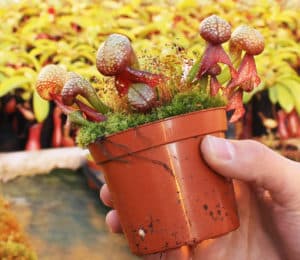BLOG: Grower report Carni Flora
We’ve been selling considerably more carnivorous plants in recent years, so it was high time to pay a visit to the nursery. A very special tour awaits us in Aalsmeer, a stone’s throw from Schiphol Airport. Owner Justin van Kessel had lots to show us and tell us about.
How did it all begin with the Carni Flora nursery?
The nursery was founded exactly 25 years ago. My father, René, was working for a plant exporter at the time, and ready for a new challenge. One of his childhood friends knew all about the world of carnivorous plants, so they set up their own nursery together. After graduating, I started working in the company, and now I own it. My father could work less now, but he’s still here full time. Shall we have a look around the greenhouses?
It’s obvious straight away that this is no ordinary plant nursery. Unlike the now common enormous greenhouses controlled by robots, in this well-organised greenhouse the plants are still intensively cared for by employees. Justin explains.
We operate in a niche market. This might not be a massive greenhouse complex, but we’ve still got the largest market share of carnivorous plants. We can fit a lot of plants in this greenhouse.
We can propagate plants ourselves, including from seed, and we get a number of species through a breeder. There are more than 60 species here. These are the plastic tunnels where the highly-vulnerable young plants grow. Not all plants make it, but once they’ve got past this stage, they’re really resilient.
Lots of these carnivorous plants are flowering..
That’s right, and the flowers are always on long stems. Do you know why? Carnivorous plants, like ‘normal’ plants, reproduce through cross-pollination of their flowers. Insects are not prey at this time, but useful allies who have to fly from one plant to another without getting trapped. That’s why the flower is high above the plant. We cut off the flowers of Dionaea muscipula during cultivation, so the plant can use all its energy internally.
So there’s quite a lot of waste, and your plants need a lot of manual care, can you still make a profit with your carnivorous plants?
On top of that, they grow incredibly slowly. The plants in our smallest pot size, 8.5-cm pot, are 1 year old. Plants in a larger pot are usually 1.5 to 2 years old, so you can see that it’s not cheap to grow these plants. We don’t give any discounts to major retailers, but concentrate on daily sales to the green trade.

This is a Darlingtonia californica, a very nice pitcher plant that we would like to add to our range. The plants grow naturally in rocky mountains with cool running water. At the moment, we’re studying whether we can grow beautiful Darlingtonia’s here in Aalsmeer.
We grow lots of different species, but even so 40% of our turnover comes from Dionaea muscipula, known as the Venus fly trap. Sarracenia, Drosera, Nepenthes and Pinguicula are other popular species. Often, a garden centre arranges an area with carnivorous plants, and starts with the Dioneae and a mixed tray of carnivorous plants . When sales start taking off, they start adding more and more species.
This might be a silly question, but do you release insects to feed your plants?
No, that’s unnecessary. These plants naturally grow in places with very nutrient-poor soil, where they survive by extracting food from dead insects. Even so, they also have roots with which they can extract nutrients from the soil. We know exactly how to feed them through the roots, so that they don’t need insects. They can start catching insects when they leave our nursery.
What are your plans for the future?
Javadoplant is a remarkably fast grower, but we also notice that we can sell more plants in general. Even so, we’re taking it easy with expansion plans, purely because it’s such a niche market. It’s important to us that the market remains demand-driven, and not dominated by an excessive supply. We’re concentrating on refining our knowledge and expertise.
Published on: 20 June 2019